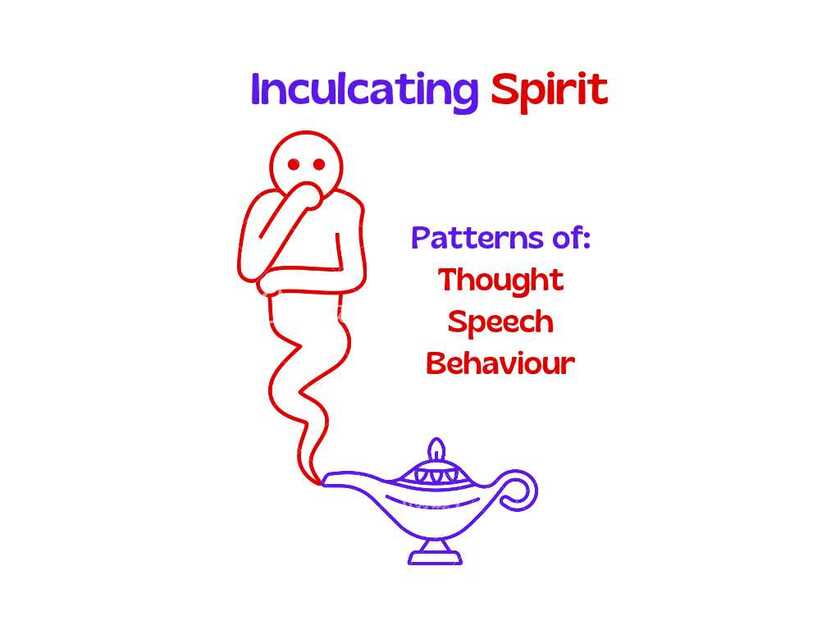
He also likes to discuss contemporary philosophy and science and is interested in putting together a scientifically comprehensive worldview that integrates metaphysics and traditional views of the soul.
Anthropology and ancient history are important as well and Aarvoll is interested in discussing theories of Atlantis, and alternative theories of human evolution and migration.
Wisdom Within — Chapter 60
The Inculcating Spirit
Every culture throughout history carries an inculcating spirit—a living pattern of energy that seeps into those who take part in it. It isn't taught in classrooms or written in manifestos; it's absorbed through rhythm, gesture, language, and imitation. It is the invisible force that tells people how to be—how to walk, speak, dress, and even think. Over time, that force becomes identity. To belong to a culture is to be inhabited by its spirit.⁵⁴¹
Take hip-hop and rap culture, for instance. Its inculcating spirit is one of dominance, resilience, and rebellion. It teaches people to move with confidence, to project power, to defy weakness. It carries the energy of survival—born from hardship, sharpened by struggle. But embedded within that same pulse lies the shadow: aggression, material obsession, and misogyny disguised as pride. Its rhythm gives rise to a walk, a talk, a whole posture toward life—one that radiates defiance but often hides deep pain.⁵⁴²
The Italian mafioso embodies a different spirit—that of loyalty, hierarchy, and silent authority. It's about respect, family, and discipline cloaked in style. The mafioso doesn't shout; his presence alone commands attention. His gestures are deliberate, his emotions restrained. Violence, when it appears, is ritual—a sacred act to restore balance. This spirit teaches composure under pressure, dignity even in danger, but also breeds paranoia and obsession with control.⁵⁴³
The pirate, by contrast, carries the spirit of rebellion in its rawest form—freedom unchained from all law. It's the romance of danger, of the sea, of living on one's own terms. This spirit attracts those who despise authority and crave adventure. It teaches boldness, cunning, and camaraderie, but also fosters recklessness and self-destruction. The pirate burns bright and lives fast; his freedom costs him peace.⁵⁴⁴
In modern archetypes, the inculcating spirit continues its quiet work. The nerd channels the spirit of obsession and intellect. He finds power through mastery—through knowing rather than dominating. His spirit values depth, precision, and imagination, but risks retreating into abstraction, where life becomes simulation rather than experience. The bimbo, in turn, carries the spirit of charm and performance. Her power lies in beauty, playfulness, and emotional intuition. Beneath her surface often hides a deep cunning—an awareness of how attention shapes value. Yet when imitated unconsciously, that same spirit becomes hollow, all reflection and no root.⁵⁴⁵
Similarly, the Chad represents effortless dominance—confidence without reflection, charisma without depth. He teaches assertion and physical presence, the power of decisiveness and ease. Yet beneath it lies the danger of arrogance and shallowness, mistaking validation for virtue. The incel, his mirror opposite, embodies alienation and resentment—a spirit forged in rejection. It teaches bitterness, self-pity, and the illusion of victimhood. Where the Chad externalizes power, the incel internalizes defeat. Both are bound by the same polarity—two sides of the same wounded masculine archetype.⁵⁴⁶
Each of these spirits, old or new, shapes behavior and worldview. They create invisible scripts that people follow without question. Music, film, and social media amplify them, turning archetypes into global identities. Over time, imitation becomes embodiment—and embodiment becomes fate.⁵⁴⁷
To see these spirits at work is to glimpse the hidden architecture of culture. To imitate unconsciously is to be lived by forces you don't understand. But to recognize them—to choose which spirit to embody—is to step into sovereignty. Every human being is, in truth, a vessel for spirit. The question is not whether you're inhabited, but by what.⁵⁴⁸
Commentary:
541: "Every culture throughout history carries an inculcating spirit—a living pattern of energy that seeps into those who take part in it. It isn't taught in classrooms or written in manifestos; it's absorbed through rhythm, gesture, language, and imitation. It is the invisible force that tells people how to be—how to walk, speak, dress, and even think. Over time, that force becomes identity. To belong to a culture is to be inhabited by its spirit."
The passage establishes the central idea: culture is not merely external but embodied. Every society instills habits, gestures, and thought patterns that shape individuals almost invisibly. Identity is an absorption of collective energy, not just personal choice.
542: "Take hip-hop and rap culture, for instance. Its inculcating spirit is one of dominance, resilience, and rebellion. It teaches people to move with confidence, to project power, to defy weakness. It carries the energy of survival—born from hardship, sharpened by struggle. But embedded within that same pulse lies the shadow: aggression, material obsession, and misogyny disguised as pride. Its rhythm gives rise to a walk, a talk, a whole posture toward life—one that radiates defiance but often hides deep pain."
This illustrates how every cultural energy carries both light and shadow. Hip-hop teaches resilience and presence, yet the same patterns propagate aggression and pride, showing how the inculcating spirit is both formative and morally complex.
543: "The Italian mafioso embodies a different spirit—that of loyalty, hierarchy, and silent authority. It's about respect, family, and discipline cloaked in style. The mafioso doesn't shout; his presence alone commands attention. His gestures are deliberate, his emotions restrained. Violence, when it appears, is ritual—a sacred act to restore balance. This spirit teaches composure under pressure, dignity even in danger, but also breeds paranoia and obsession with control."
Here, the mafioso demonstrates a disciplined, hierarchical spirit. The teaching is subtle—command without display—but it carries both integrity and the danger of obsession. Power and caution are intertwined.
544: "The pirate, by contrast, carries the spirit of rebellion in its rawest form—freedom unchained from all law. It's the romance of danger, of the sea, of living on one's own terms. This spirit attracts those who despise authority and crave adventure. It teaches boldness, cunning, and camaraderie, but also fosters recklessness and self-destruction. The pirate burns bright and lives fast; his freedom costs him peace."
The pirate exemplifies pure rebellion. Freedom is exalted, yet it carries consequences: risk, chaos, and impermanence. Embodying this spirit comes at the cost of stability and serenity.
545: "In modern archetypes, the inculcating spirit continues its quiet work. The nerd channels the spirit of obsession and intellect. He finds power through mastery—through knowing rather than dominating. His spirit values depth, precision, and imagination, but risks retreating into abstraction, where life becomes simulation rather than experience. The bimbo, in turn, carries the spirit of charm and performance. Her power lies in beauty, playfulness, and emotional intuition. Beneath her surface often hides a deep cunning—an awareness of how attention shapes value. Yet when imitated unconsciously, that same spirit becomes hollow, all reflection and no root."
Modern archetypes show how the inculcating spirit functions in contemporary society. The nerd and bimbo archetypes highlight the duality in how archetypal energies can be realized. Mastery, charm, and intellect are valuable, yet misapplied or unconsciously mimicked, they hollow the soul, creating surface-level imitation without depth.
546: "Similarly, the Chad represents effortless dominance—confidence without reflection, charisma without depth. He teaches assertion and physical presence, the power of decisiveness and ease. Yet beneath it lies the danger of arrogance and shallowness, mistaking validation for virtue. The incel, his mirror opposite, embodies alienation and resentment—a spirit forged in rejection. It teaches bitterness, self-pity, and the illusion of victimhood. Where the Chad externalizes power, the incel internalizes defeat. Both are bound by the same polarity—two sides of the same wounded masculine archetype."
This passage reveals the shadowed dance of masculine extremes: the Chad and the incel are not merely social types but archetypal expressions of power and lack. One radiates effortless confidence that risks superficiality; the other harbors internalized pain that risks bitterness. Together, they illustrate the spectrum of the wounded masculine—how external bravado and internal defeat are entwined reflections of the same underlying imbalance.
547: "Each of these spirits, old or new, shapes behavior and worldview. They create invisible scripts that people follow without question. Music, film, and social media amplify them, turning archetypes into global identities. Over time, imitation becomes embodiment—and embodiment becomes fate."
The text captures the mechanistic power of culture: repeated exposure programs the mind. Media amplifies, imitation embeds, and what begins as external influence becomes internalized destiny.
548: "To see these spirits at work is to glimpse the hidden architecture of culture. To imitate unconsciously is to be lived by forces you don't understand. But to recognize them—to choose which spirit to embody—is to step into sovereignty. Every human being is, in truth, a vessel for spirit. The question is not whether you're inhabited, but by what."
Recognition is the gateway to mastery. The text emphasizes that choice restores agency. Sovereignty comes not from rejecting culture but from consciously selecting which energies to integrate. The soul becomes author rather than puppet.

Rest of the chapters are in the link below. I'm leaving for the monastery tomorrow and won't be returning to the worldly life again. I'm sorry if it seemed like I was just imposing my worldview on your channel Aarvoll without your permission. I just saw a lot of myself in you—a noble Aryan spirit who only wants the best for all of human kind—and I couldn't help but wanting to share my ideas with you before I left for good. I really think you could truly create something special out of them.
Wisdom Within — Chapter 59
The Imitation Game
Human beings are creatures of imitation. From the moment we are born, we learn by observing and copying. We mirror the tone of our parents’ voices, the gestures of our friends, the language of our culture. Imitation is how the mind absorbs reality—it’s the bridge between perception and embodiment. What we see repeatedly, we eventually become.⁵³⁴
This instinct, once essential for survival, has been weaponized in the modern age. Today, the models we imitate no longer come from the village or the family, but from the screen. The faces we see on television, in movies, and on social media become our mirrors. They define what it means to be strong, beautiful, intelligent, or desirable. When the same images repeat over and over, they form invisible molds for identity. The more we absorb them, the more we unconsciously shape ourselves to fit them.⁵³⁵
Consider how this works: the awkward, apologetic male who doubts himself; the hyper-independent woman who needs no one; the...












